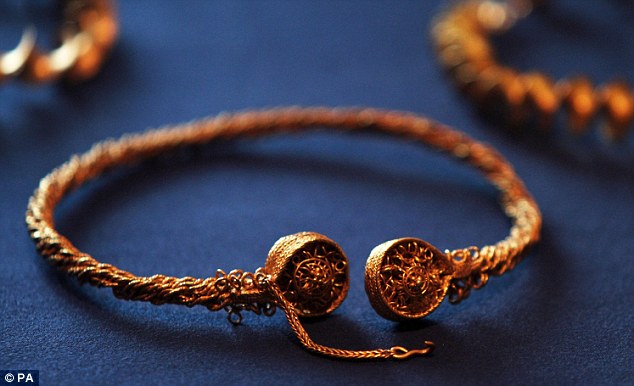 Sunday - January 03, 2010
Sunday - January 03, 2010
WEDNESDAY , JANUARY 3, 1940. LITTLE FINLAND AT WAR, NO PUSHOVER AS SOVIETS LEARN
This war started about 1934 between the Russians and Finland. PROUD little Finland who before they were forced by numbers and I forget what else to conceed the field, gave the Soviets a very bloody nose.
How damn depressing and sad then to know that today, after all they fought for, they’ve become as PC as the rest of Europe. God that thought is depressing.
Talk about a band of brothers. well we weren’t were we? I just brought it up.
That’s cos the Telegraph has been charting the course of the Second World War day by day in these little boxed blurbs. You can go to their site for lots more on the subject. But this caught my eye. And so I share as usual, my interests with you.
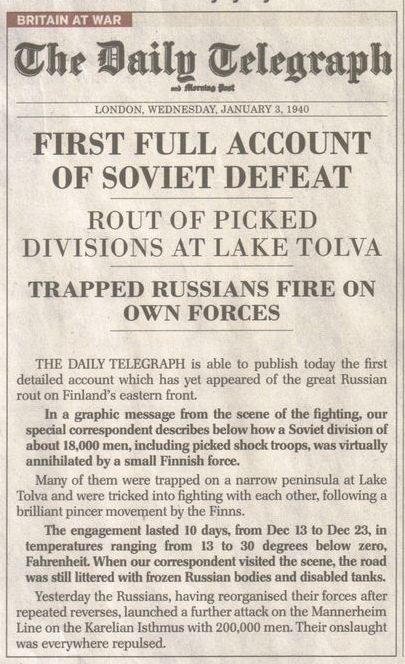
I hope that shows up readable on your screens. If it doesn’t, here’s what it says.
The Daily Telegraph is able to publish today the first detailed account which has yet appeared of the great Russian rout on Finlands eastern front.
In a graphic message from the scene of the fighting, our special correspondent describes below how a Soviet division of about 18,000 men, including picked shock troops, was virtually annihilated by a small Finnish force.
Many of them were trapped on a narrow peninsula at Lake Tolva and were tricked into fighting with each other, following a brilliant pincer movement by the Finns.The engagement lasted ten days, from Dec 13 to Dec 23, in temperatures ranging from 13 to 30 degrees below zero, Fahrenheit. When our correspondent visited the scene, the road was still littered with frozen Russian bodies and disabled tanks.
Yesterday the Russians, having reorganised their forces after repeated reverses, launched a further attack on the Mannerheim Line on the Karelian Isthmus with 200,000 men.
Their onslaught was everywhere repulsed.
Britain at War
Telegraph.co.uk is publishing daily articles from the archive 70 years ago chronicling the build-up to the Second World War, as well as 10 features by leading historian Andrew Roberts, illustrated with video. Readers can share their recollections at the end of each article.
http://www.telegraph.co.uk/news/newstopics/britainatwar/
Posted by peiper
Filed Under: • History • UK •
• Comments (0)
 Tuesday - December 22, 2009
Tuesday - December 22, 2009
SOMETHING A LITTLE DIFFERENT TO END MY EVENING HERE. ALSO FITS THE SEASON.
I have visited this wondrous place on more then one occasion. For all my ranting and griping and complaining fits of temper with this country, I suppose I’m lucky living in a place with so much history. Not only that, but living in an age of digital cameras where I can record some of what I see. Which would mean not a lot if I couldn’t share some of it now and then. Still, these shots don’t quite convey what walking up that stairway to this ancient church is like. Or being inside it all alone. No tourists. Just myself. Darn. Almost makes me wish I were religious. Well think about it. I feel like I’m missing something. Maybe it’s the season.
ST. SWITHUN’S CHURCH, WINCHESTER, ENGLAND
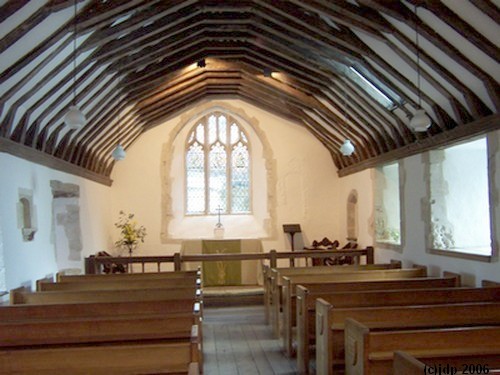
St Swithun-upon-Kingsgate is a very special church, one of the medieval gems of Winchester, built over one of its city gates on the line of the foundations of the Roman City wall. The first surviving reference to Kingsgate occurred in 1148, that to the church itself in 1264, when it was burned down. St Swithun-upon-Kingsgate has therefore been a house of prayer for at least seven hundred and fifty years.
HERE’S ONE VIEW OF KING’S GATE. I don’t know if they actually still close it at night. Never thought about that till now. On the other side is the Winchester Cathedral Close. It houses buildings (olde) for retired clergy and anyone who’d been working for Winchester Cathedral.
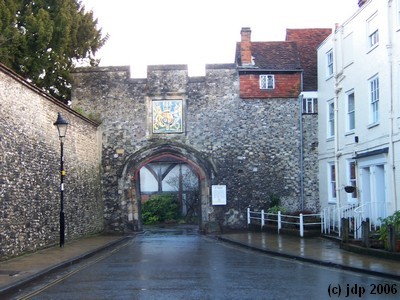
Although common in medieval times, churches built over medieval city gates are now very rare. In those times, travel was dangerous, and it would have been common for travellers and pilgrims to give thanks for a safe journey in such a church. In the days before literacy was common, people would have used its wall paintings, statues, and other features as aids to their thanksgiving prayer.
NO SURPRISE HERE. THE CHURCH IS OVER THE ARCH.
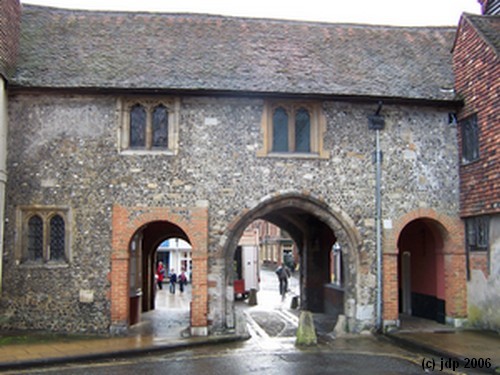
AND HERE’S THE ENTRANCE, TO THE RIGHT OF THE ARCH UNDER THAT STEEP ROOF LINE.
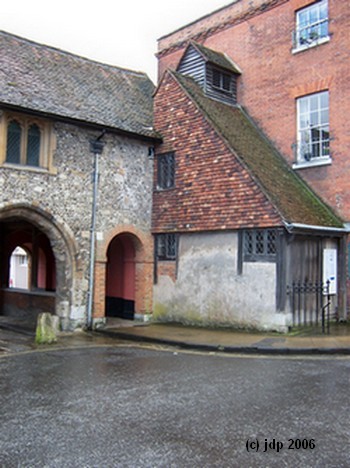
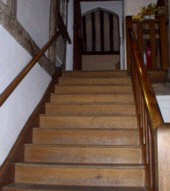
THE PHOTO OF THE STAIRS GOING UP IS NOT MINE. IT WAS ON THE NET.
I TOOK THIS ONE COMING DOWN. I STILL CAN’T RECALL WHY I COULDN’T GET A SHOT GOING UP.
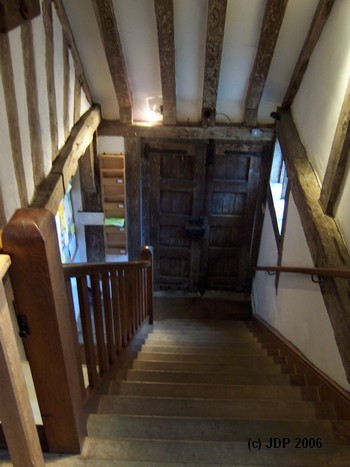
In the 1660’s, the porter of Kingsgate, Robert Allen, lived in the church and kept pigs in it. It is certainly possible that children were born here in something resembling the conditions of a stable. Also, as a very special upper room, the Parish is extremely fortunate to have this building as one of its churches. There could hardly be a better place to remember the incarnation and to celebrate the Last Supper. In these surroundings, it is not difficult to feel the thanksgiving, which is at the heart of any Eucharist. Many people come to sit here in silent thanksgiving. For the passing visitor or modern pilgrim, this is a great blessing but this building has much more to offer.
As we look at its features, it is not difficult to realise that they have a story to tell. We have put together some of these stories to help people on their own spiritual journeys. It is possible to do the same for churches and buildings in all our lives and we hope that this will encourage you to do so.
History
The Roman foundations of the city wall, of which Kingsgate arch is a part, can be seen near the river and also exist in the cellars of some houses in St Swithun Street. The arch is mentioned in the so-called Winchester Domesday Book in 1148. The first mention of St Swithun-upon-Kingsgate is in 1264 when citizens burned it down in a dispute with the Prior of the Abbey. The church was probably a chapel for lay people who worked for the Abbey in medieval times. Its walls were decorated with paintings, the statues removed by Cromwell’s reformers would still have been in the three niches, and there was glass in the windows.
HERE’S ANOTHER VIEW OF THE KINGSGATE: SMALL SAMPLE OF THE HOMES IN THE CATHEDRAL CLOSE AND OCCUPIED BY CLERGY (RETIRED) AND PPL ASSOCIATED WITH THE CATHEDRAL.
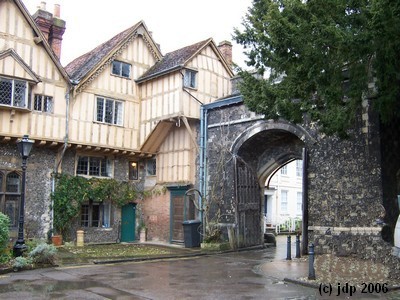
The Prior paid four shilling and eight pence to have the glass repaired in 1484. In 1660, the building was in a sad state of repair and misuse; Robert Allen, the porter of Kingsgate, lived in one end and kept pigs in the other. By 1677 it had been repaired and its bells re-hung. After the shrine of St Swithun in the Cathedral was destroyed in September 1538 and the Monastery dissolved in November 1539, it became a parish church and is now part of the parish of St Lawrence with St Swithun.
The church features in literature as Anthony Trollope’s St Cuthbert’s in his novel ‘The Warden’.
St. Swithin’s Day is 15 July, a day on which people watch the weather for tradition says that whatever the weather is like on St. Swithin’s Day, it will continue so for the next forty days. There is a weather-rhyme is well known throughout the British Isles since Elizabethan times.
‘St. Swithin’s day if thou dost rain
For forty days it will remain
St. Swithin’s day if thou be fair
For forty days ‘twill rain nae mair.
‘dost = doesthou =
younae mair = no moreSt Swithun was a Saxon Bishop of Winchester.
He was born in the kingdom of Wessex and educated in its capital, Winchester. He was famous for charitable gifts and building churches.Why do people watch the weather on St. Swithin’s day?A legend says that as the Bishop lay on his deathbed, he asked to be buried out of doors, where he would be trodden on and rained on. For nine years, his wishes were followed, but then, the monks of Winchester attempted to remove his remains to a splendid shrine inside the cathedral on 15 July 971. According to legend there was a heavy rain storm either during the ceremony or on its anniversary.This led to the old wives’ tale that if it rains on St Swithin’s Day (July 15th), it will rain for the next 40 days in succession, and a fine 15th July will be followed by 40 days of fine weather.
http://www.woodlands-junior.kent.sch.uk/customs/stswithun.html
St Swithun biography
(d. 862)
Very little is known for certain about the life of Winchester Cathedral’s first patron saint. Some biographies of Swithun state that he was once Prior of Winchester, but there is no evidence to support this belief. We do know that he was one of the chief advisors of Egbert, King of the West Saxons, and may have been responsible for the education of Egbert’s son, Ethelwulf. Egbert’s influence procured for Swithun the post of Bishop of Winchester, which he took up in 852.
When Swithun’s health failed in 862, and he lay near death, he is said to have asked that his body be buried outside his cathedral, rather than within it, as was customary. He wanted passers-by to walk upon his grave, and raindrops from the eaves of the cathedral fall upon his resting place. Although his wishes were granted, his grave did not long lie undisturbed. In 931 Bishop Ethelwulf had Swithun disinterred and reburied within the walls of the new church.
Shortly after, miracles were reported at Swithun’s tomb, which became a popular attraction for pilgrims. So clamorous were the voices reporting these miracles that Swithun was canonized, which further added to the allure of his shrine.
Yet, still his bones could not rest, for in 1093 his remains were once more dug up and reburied with great ceremony within the new cathedral built by Bishop Walkelin. There they remained until the Dissolution of the Monasteries in 1538, when the shrine wa destroyed by Henry VIII’s men. Once more the saint’s bones were dug up, this time to scattered and lost for good.
ABOUT A BLOCK AWAY FROM THE CHURCH OR A FRACTION MORE BUT NOT MUCH, ON JULY 18, 1817, JANE AUSTEN SADLY DIED, TOO YOUNG AND WITH AN UNFINISHED BOOK.
SHE PASSED AWAY IN THIS HOUSE.
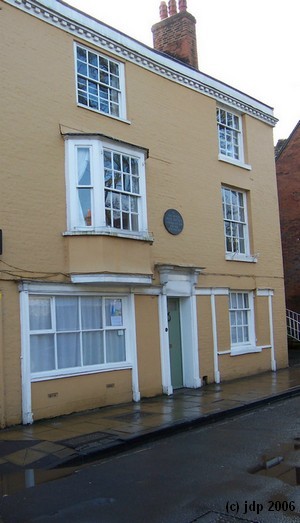
Posted by peiper
Filed Under: • Art-Photography • History • Religion • UK •
• Comments (4)
 Friday - December 11, 2009
Friday - December 11, 2009
chesterfield cigarettes. not a cough in a carload. lucky strike green goes to war.
Hey ... that’s how they used to advertise guys. Chesterfield boasted not a cough in a carload in the 30’s and possibly early 40s.
Lucky Strike cigarettes used to have a green colored pack. Once America went to war in 1941, they couldn’t get green dye I guess. They went to the white pack I’m familiar with as I smoked those things steadily for 38 years. Unfiltered. In 1941 they advertised, Lucky Strike Green goes to war, and went to the white package.
But way,way before then ...like way before. Well known actresses appeared on packs. Like this brand.

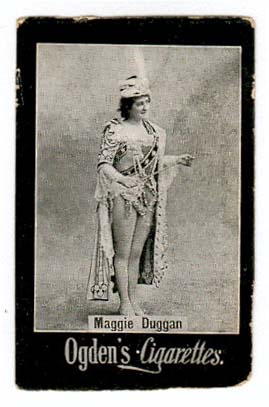

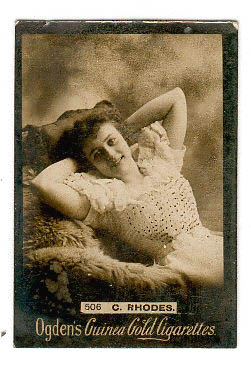
Smoke,smoke,smoke that cigarette. So I did. But times and tastes changed. And so did cigarette ads and images.
From 1933. Lucky Strike Green
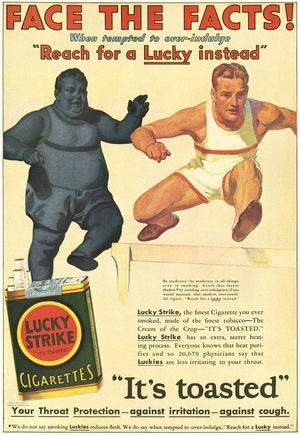
Not a Cough in a carload. 1940

I tried smoking Old Gold because I liked the package design. But quickly went back to Luckies and stayed there.

By 1948, the folks who made my coffin nails had TV and things got interesting before they settled down to just plain dull and boring.
This was great stuff in ‘48.
H/T http://www.archive.org/details/LuckyStr1948
But in modern times like today ..... the makers can make us look like this and not only that. Vitamins too. But I don’t wanna look like her.
So here I am stuck. Old,bald, over the hill and waiting for a water heater to be installed tomorrow. GUARANTEED!

OK, hang on. Youthful Glow I can accept. I can live with that. (cough)
Posted by peiper
Filed Under: • History • Miscellaneous • Personal •
• Comments (4)
 Monday - December 07, 2009
Monday - December 07, 2009
Pearl Harbor Day
Roosevelt didn’t bow. Nor did he apologize.
50 years later, neither did President Bush
From the remarks delivered by President Bush to World War II veterans and families at Kilo 8 Pier, Honolulu, Hawaii, on December 7, 1991 — the 50th anniversary of Pearl Harbor Day:
I expect if we went around the room, all of us would remember. I remember exactly when I first heard the news about Pearl Harbor. I was 17 years old, walking across the green at school. And my thoughts in those days didn’t run to world events, but mainly to simpler things, more mundane things like making the basketball team or entering college. And that walk across the campus marked an end of innocence for me.
When Americans heard the news, they froze in shock. But just as quickly we came together. Like all American kids back then, I was swept up in it. I decided that very day to go into the Navy to become a Navy pilot. And so, on my 18th birthday — June 12, 1942 — I was sworn into the Navy as a Seaman Second Class.
And I was shocked — I was shocked at my first sight of Pearl Harbor several months later — April of ཨ. We came into port on the carrier San Jacinto. Nearby, the Utah was still on her side, parts of the Arizona still stood silent in the water. Everywhere the skeletons of ships reached out as if to demand remembrance and warn us of our own mortality.
Over 2,000 men died in a matter of minutes on this site, a half century ago. Many more died that same day as Japanese forces assaulted the Philippines and Guam and Wake Island, Midway, Malaya, Thailand, Singapore, Hong Kong. On that day of infamy, Pearl Harbor propelled each of us into a titanic contest for mankind’s future. It galvanized the American spirit as never before into a single-minded resolve that could produce only one thing — victory . . .
God rest the souls of our servicemen who died that day. And God bless the nation that stood up to fight en masse the day after, and kept right on fighting until they had completely won.
And look at us today with our 9/10 attitude, terrorists on trial in NYC, PC in the military that gets people killed, ROEs that won’t allow our troops to fight, and a dribs ‘n drabs reinforcement effort in Afghanistan that comes with a pullout timeline.
We are not worthy.

No. Let me rephrase that.
Our leadership is not worthy.
Posted by Drew458
Filed Under: • History • Military •
• Comments (6)
 Friday - December 04, 2009
Friday - December 04, 2009
A number of words about Switzerland from the Conservative Voice of Europe
I was led to this site via Europe News.
The guy writes exceptionally well BUT .... I know it’s a serious subject and I do find it interesting except it’s so darn long. So I haven’t posted all of it here. In fact, I can’t read all this at one sitting on line and am going to print it out. But what I have read is well worth my trouble. I think you will be interested in what he has to say as well.
The site is The Brussels Journal, which calls itself the Conservative Voice of Europe.
SWITZERLAND: THE GOVERNMENT -VS- THE PEOPLE
Brussels Journal 3 December 2009
By George HandleryGeorge Handlery about the week that was. Even in small countries, major trends can unfold early. About noble leaders and their reluctant peons that refuse to follow.
International protest and its use to the tottering local leadership. Security, fear and freedom. Radicalization as a face saving device. Immigration then and now. Imported prejudices, failure and the allegation of discrimination.
1. Small country, major issue. Normally, Switzerland is not of much interest to the international reader. Already by standing falsely accused of having invented the cuckoo clock, she is automatically downgraded. The neglect can also be attributed to her size, a functioning system – a juicy crisis brings attention.
Not being on the map is also the consequence of her ability to keep out of armed conflicts. Switzerland did not even need to be liberated in WW2! Some myths shatter on Swiss reality.
Effective armed neutrality invalidates a peacenik thesis that arms lead to war. Per capita Tell’s land has a huge army – 600,000 in WW2 out of 4.5 million. Reflecting her industrialization and armament industry, it is largely self sufficient and excellently equipped to exploit the best defense positions nature can provide.
Complete the achievements with Switzerland‘s top rating regarding the quality of life and the top earned per capita GDP coupled to being a leading financial center. In the case of a landlocked and no-resources country, this should not be the case. Besides bank secrecy – which is a settled issue and gone by now – Switzerland is currently getting perplexed attention because of the consequence of her direct democracy.
On a regular basis, the unique system enables the people to perform executive functions. The voter can make laws and invalidate legislative action. Therefore, if you want to know what the “people” want, then you might find out by consulting the results of the numerous referendums and initiatives. The people’s uncensored voice expressing its real opinion is a good indicator of what comparable societies would say if they would be able to speak up.
The latest, and internationally widely commented, Swiss initiative forbade the erection of further minarets. Expressly not effected are existing structures and new temples as well as the exercise of any religion.

To the surprise of all, the initiative passed in what is rated here as a landslide. The decision went against the will of the executive, the legislature, all but one of the political parties, the churches, the economic and social elites, “business,” the media and, belatedly, the Vatican. Why “surprise”? Opinion surveys predicted rejection. That teaches us right away something about surveys in general.
People give PC responses to surveyors who are themselves PC. This is what makes surveys into useful weapons in the hands of those who can afford them. More important is another insight. It suggests that the governments, parliaments and the elites of western democracies might not quite express the will of those they claim to represent.
Additionally, thanks to the media control of the political class, real public opinion does not always equal what little people are made to think by pundits that have the power to determine what proper views must be.
Now, “the day after”, Europe’s governments and institutions condemn the vote’s result and the voters who “committed” the outrage. Amnesty International finds that the Swiss voted “against religious freedom”. “Scandalized” France’s Foreign Minister bemoans the same – while his government forbids burqas. Those veils express in textile what the minarets say in stone.
(Oddly, with eight times the population, France has 5 minarets and 500 mosques while Switzerland has four minarets.) Indeed, governments and the governing elite’s shock and outrage might have a simple reason. It flows not from principle but reflects interest. They attack the frightening precedent created by the Swiss because the political classes fear their own peoples. Just take a fresh opinion survey from Germany. There 70% (sound too high to the writer) of the “barefooted” would vote – if their system would let them – the way the Swiss have.
GOOD TO KNOW: THE FINAL CHAPTER IS NOT YET WRITTEN
The defeated leadership chides the voters about their mistake. In addition, the disavowed local political class tries to assert itself against its recalcitrant people. One way to do that is to encourage international pressure to demand that the new law not be implemented. The minaret-builders are not idle either. Emboldened by the angered local elite, they will ultimately turn to international courts – such as the one that forbade the display of crosses in Italian schools – demanding that religious freedom be protected. Naturally, that bold and principled pronouncement will limit itself to Switzerland as representing Europe. So as to avoid insult, the decision will ignore Middle Eastern states or Taliban ruled areas.
2. A sign of the times. A friend has submitted a letter to the editor. Without mentioning the minarets, the note raises questions regarding demonstrators that protested the vote’s result. He was advised that, in the interest of his own safety and the careers of his children (one is married to a Muslim), he should desist. While the fears moving him seem to be exaggerated, the man wrote to the paper requesting that his submission not be published.
It is not conceivable that, had he supported the after-the-fact demonstrations or “minarets for all”, anyone would have discovered a risk implied by turning to the Editor. The case suggests two points to be made here. 1. Without security there is no freedom. 2. Fear cancels out liberty.
Posted by peiper
Filed Under: • Editorials • Government • History • Illegal-Aliens and Immigration • International • Media-Bias • Politics • RoPMA •
• Comments (0)
 Monday - November 23, 2009
Monday - November 23, 2009
A reply to Argentium G. Tiger and Drew
This came up in my previous post Et Tu? Warner Bros?
Tiger, as far as I know, you have the right to do whatever you want to a DVD that you purchase, as long as you aren’t selling (or even giving away, perhaps) the end product that you have created. Sounds like you’re making a backup copy of the data with some extra editing. I don’t see a problem
So says Drew. Frankly, I agree with him. But is it legal? Here’s the FBI Anti-Piracy Warning:

Please note the phrase ‘infringement without monetary gain’.
Granted, the likelihood of you getting caught making ‘backup copies’ of dvds that you own is low. However, the dvd in question is a rental from Netflix. I do not own it. So it would be most inappropriate for me to do anything resembling what Tiger suggested.
Personally, as for Tiger mentioning what software he uses, I’d have said nyet. Those who want to skirt copyright laws should do what I and presumably Tiger have done: your own research. Quietly and privately.
BTW, none of Tiger’s software work for Macs. ![]()
Greyjohn: ‘Sufferin’ Succotash’ was the trademark of Snagglepuss, a Hanna-Barbera character, not a Warner Bros/Looney Tunes character. Last time I rented a Hanna-Barbera cartoon dvd (Snagglepus, Yogi Bear, Boo Boo, etc) it was interesting for a completely different reason:
The Hanna-Barbera cartoons included the commercials. Yogi Bear was extolling the virtues of Post Honey Comb cereal, among other things.
Posted by Christopher
Filed Under: • Blog Stuff • Editorials • History •
• Comments (10)
 Monday - November 09, 2009
Monday - November 09, 2009
We were fools to think the fall of the Berlin Wall had killed off the far Left.
She’s wrong about “they’re back.”
Because the SOBs never left us. And haven’t some of us been bitching about the enemy screwing us from within for a long time?
I have wondered for a long time, just how it was possible for the left to be so well organized, that they have managed to bring us to this place we now find ourselves in. Well, I think Melanie Phillips has answered my question.
I have posted her entire editorial here, rather then only part of it . She really has nailed it.
Now where do we go from here?
I HOPE YOU WILL READ ALL OF THIS!
We were fools to think the fall of the Berlin Wall had killed off the far Left.
They’re back - and attacking us from within
By Melanie Phillips
Daily Mail
Monday Nov 9 2009Twenty years ago today, supporters of freedom and human rights cheered and wept for joy as the Berlin Wall was torn down by jubilant young Germans.
To so many, that heady day seemed to herald the emergence of a better world. The spectre of communism had finally been laid to rest. Liberty had triumphed over tyranny.
The end of the Cold War even led some to proclaim that this was ‘the end of history’ - which was to say that liberal democracy was now the dominant and unchallengeable force in the world.
East German border guards looking through a hole in the Berlin wallThe collapse of communism was actually a slow-burning process. Its moral and political bankruptcy became obvious decades before that glorious Berlin day in November 1989
However, the 9/11 attacks on America tragically proved this to be absurdly over-optimistic. The eruption of radical Islamism revealed that, while the West may have been rid of one enemy in the Soviet Union, another deadly foe had risen to take its place. So much is, sadly, all too evident.
But what is perhaps less obvious is that communism did not just vanish in a puff of historical smoke. The Soviet Union was defeated and fell apart, for sure. But the communist ideology that fuelled it did not so much disintegrate as reconstitute itself into another, even more deadly form as the active enemy of western freedom.SUBVERSIVE
Soviet Communism was a belief system whose goal was to overturn the structures of society through the control of economic and political life. This mutated into a post-communist ideology of the Left, whose no-less ambitious aim was to overturn western society through a subversive transformation of its culture.
To grasp the extent to which this has in fact taken place, we have to go back in time to well before the moment the Berlin Wall fell. The collapse of communism was actually a slow-burning process. Its moral and political bankruptcy became obvious decades before that glorious Berlin day in November 1989.
For many communist fellow travellers, the scales fell from their eyes when the Hungarian uprising was crushed in 1956. Others, over the years, lost faith not just in communism but in its less radical sister, socialism, as their core tenet of ‘equality’ proved itself in a myriad different ways to be the enemy of freedom and justice, with market forces appearing to carry the torch of liberty instead.
But as communism slowly crumbled, those on the far-Left who remained hostile towards western civilisation found another way to realise their goal of bringing it down.
This was what might be called ‘cultural Marxism’. It was based on the understanding that what holds a society together are the pillars of its culture: the structures and institutions of education, family, law, media and religion. Transform the principles that these embody and you can thus destroy the society they have shaped.
This key insight was developed in particular by an Italian Marxist philosopher called Antonio Gramsci. His thinking was taken up by Sixties radicals - who are, of course, the generation that holds power in the West today.
Gramsci understood that the working class would never rise up to seize the levers of ‘production, distribution and exchange’ as communism had prophesied. Economics was not the path to revolution.
He believed instead that society could be overthrown if the values underpinning it could be turned into their antithesis: if its core principles were replaced by those of groups who were considered to be outsiders or who actively transgressed the moral codes of that society.
So he advocated a ‘long march through the institutions’ to capture the citadels of the culture and turn them into a collective fifth column, undermining from within and turning all the core values of society upside-down and inside-out.
THIS STRATEGY HAS BEEN CARRIED OUT TO THE LETTER
The nuclear family has been widely shattered. Illegitimacy was transformed from a stigma into a ‘right’. The tragic disadvantage of fatherlessness was redefined as a neutrally-viewed ‘lifestyle choice’.
Education was wrecked, with its core tenet of transmitting a culture to successive generations replaced by the idea that what children already knew was of superior value to anything the adult world might foist upon them.
The outcome of this ‘child-centred’ approach has been widespread illiteracy and ignorance and an eroded capacity for independent thought.
MISDEEDS
Law and order were similarly undermined, with criminals deemed to be beyond punishment since they were ‘victims’ of society and with illegal drugtaking tacitly encouraged by a campaign to denigrate anti-drugs laws.
The ‘rights’ agenda - commonly known as ‘political correctness’ - turned morality inside out by excusing any misdeeds by self-designated ‘victim’ groups on the grounds that such ‘victims’ could never be held responsible for what they did.
Feminism, anti-racism and gay rights thus turned men, white people and Christians into the enemies of decency who were forced to jump through hoops to prove their virtue.
This Through The Looking Glass mindset rests on the belief that the world is divided into the powerful (who are responsible for all bad things) and the oppressed (who are responsible for none of them).
This is a Marxist doctrine. But the extent to which such Marxist thinking has been taken up unwittingly even by the Establishment was illustrated by the astounding observation made in 2005 by the then senior law lord, Lord Bingham, that human rights law was all about protecting ‘oppressed’ minorities from the majority.
None of this is to say there has been a giant, organised conspiracy to undermine Britain in this way. Admittedly, some Left-wingers did so conspire, but many others bought into these ideas for different reasons.
Of particular importance was the demoralisation of the British ruling class by the loss of Empire and the indebtedness of Britain to America at the end of World War II - a profound loss of cultural nerve that made the Establishment vulnerable to any ideas, however outlandish, that promised to bring about the New Jerusalem.
These ideas gained general traction within the intelligentsia, the universities and the media - which is why the BBC is so institutionally skewed towards political correctness.
TOTALITARIANHowever, the terrifying fact is that they form a totalitarian mindset that replicates the way communist societies clamped down on any other than permitted views. Thus the intolerance - or even arrest - of Christians opposed to gay adoption and civil union, or the vilification as ‘racists’ of those opposed to mass immigration.
This mindset also led to the belief that a sense of nationhood was the cause of all the ills in the world, precisely because western nations embodied western values. So transnational institutions or doctrines such as the EU, UN, international law or human rights law came to trump national laws and values.
But the truth is that to be hostile to the western nation is to be hostile to democracy. And indeed, with the development of the EU superstate we can see that the victory over one anti-democratic regime within Europe - the Soviet Union - has been followed by surrender to another.
For the republic of Euroland puts loyalty to itself higher than that to individual nations and their values. It refused to commit itself in its constitution to uphold Christianity, the foundation of western morality.
Instead, it is committed to moral and cultural relativism, which sets group against group and guarantees supreme and antidemocratic power to the bureaucrats setting the rules of ‘diversity’ and outlawing all dissent from permitted attitudes.
When the Berlin Wall fell, we told ourselves that this was the end of ideology. We could not have been more wrong.
The Iron Curtain came down only to be replaced by a rainbow-hued knuckle-duster, as our cultural commissars pulverise all forbidden attitudes in order to reshape western society into a post-democratic, post-Christian, post-moral universe. Lenin would have smiled.
Posted by peiper
Filed Under: • Commies • CULTURE IN DECLINE • FREEDOM • History • UK •
• Comments (3)
 Thursday - November 05, 2009
Thursday - November 05, 2009
Amateur treasure hunter finds £1m hoard of ancient golden jewellery. AWESOME FIND !
This kind of thing is so mind bending. IRON AGE and take a look at the workmanship. Look how intricate that tiny chain is.
I would never have thought they could do that in the Iron Age. And that little chain that hooks things together. My gosh, it’s up to date modern.
Be sure and see all the photos at the link provided.
HIS DAY JOB

On first time out with his metal detector, amateur treasure hunter finds £1m hoard of ancient golden jewellery
By SARAH BRUCE
Last updated at 12:27 PM on 05th November 2009When David Booth bought himself a metal detector, he was looking for a new hobby – and perhaps the occasional old coin.
But on his very first outing with the device, he uncovered a £1million hoard of Iron Age jewellery that is Scotland’s most important find in a century.
Mr Booth, 35, found four gold necklaces – known as ‘torcs’ – buried just six inches beneath the surface in a field near Stirling.Up until his amazing find, he had only switched the £240 gadget on to ‘detect’ knives and forks in his own kitchen as practice.
But just one hour into his first outdoor foray – and only seven paces from where he had parked the car – he became the country’s most famous finder.
The hoard – dating back as far as 300BC - has excited archaeologists so much, they say it changes the way we look at Scotland’s ancient inhabitants.
And under treasure trove rules in this country, the safari park keeper is set to get a reward equal to the market value of the find.But a shell-shocked Mr Booth is finding it hard to come to terms with his imminent wealth – the father-to-be can think no further than ‘perhaps’ paying off his Ford Focus car loan with his riches.
He said: ‘I’d always fancied buying a metal detector, just as a hobby, and I decided to do it. It turned out to be a pretty good investment.‘I was really only there because I had permission from the landowner, although I knew the area had some Iron Age history.
‘I just parked the car in the field, took my metal detector out and started looking – I just had a feeling about it.
‘It flashed to indicate that I had found gold about seven paces away from the car, and I started digging. ‘I knew I had to be careful, so I dug quite a large circle around the spot with a garden spade.‘I used a trowel when I got nearer. Six or eight inches down, I saw a glimpse of one of them, then uncovered the rest of the hoard. They were in a wee group.
‘My first feeling was one of almost disbelief. I knew it was gold, and it did look old, but I couldn’t believe I could be so lucky.’
Mr Booth took the collection of muddy artifacts home on September 28 and rinsed them carefully to uncover a cache of glittering jewellery.
The find was in five pieces – three intact necklets and two fragments of another torc, all gold and silver alloy with a touch of copper.Two of the pieces are ribbon torcs, twisted carefully from sheet gold with flattened ends. These are Scottish or Irish in origin.
The fragments are from a South-west French style annular torc, which would have been an enclosed circle with a hinge and catch.But the piece that is really getting experts excited is a looped terminal torc with decorative ends, made from eight golden wires looped together and decorated with thin threads and chains. All the pieces date to between 300 and 100 BC.
The Stirling find appears to reveal links between local tribes — traditionally seen as isolated — and other Iron Age people in Europe.The treasure spent the night in Mr Booth’s gun safe in the house he shares with girlfriend Carolyn Morrison, 28. The next day, he took them to work and notified the National Museum of Scotland (NMS), who were at the door within hours of receiving an email and pictures of the find.
The museum’s principal Iron Age and Roman curator Dr Fraser Hunter was one of the first on the scene, and soon a dig was set up at the top secret location where the cache was found.
He said: ‘When I saw the pictures, I nearly fell off my chair.’
As the jewellery was analysed, the site of the find also yielded more information.MORE ARTICLE AND LOTS MORE PHOTOS HERE
Man oh man LOOK at that thing! Jeez! IRON AGE? Good Grief. What year was that? 1950? Check out that link above.
LOVE this stuff.
Posted by peiper
Filed Under: • Archeology / Anthropology • History • UK •
• Comments (1)
 Thursday - October 29, 2009
Thursday - October 29, 2009
WWI soldier’s hidden diary reveals amazing trench truces
You folks MUST see the link for this amazing story.
I always seem to be surprised when things like this suddenly turn up, because I think most if not all the vets from that time are gone, and after all, how much else can there be left. Well, lots more I guess.
His sister recently passed away aged 99. His diaries and letters were stored away all these many years. Gosh.
When we read about what these guys (on both sides) saw and did and put up with, on the one hand I can imagine how deadly and how sickening it must have been. But there’s a huge difference between me thinking I can imagine it, and living through what they lived through.
And how sad that he survived the war only to die at a very young age of TB. Which was a scourge in those days. Death is so damn unfair.
What a total bummer. I’ll never be convinced that a million other guys lived and died in those god forsaken trenches, so that England could become what it is today. It’s sad beyond belief to the point of tears. It seems like everything two generations bled for has been flushed out to sea.
Anyway ....
Come on over, Fritz! WWI soldier’s hidden diary reveals amazing trench truces soldiers would call to yell names at each other
By Cher Thornhill
Last updated at 10:01 AM on 29th October 2009With shells screaming overhead and German snipers only 75 yards away, just staying alive was a remarkable achievement.
Yet huddled in the mud-filled trenches, Sapper John T French found the time to compile a remarkable diary.
Its pencil-written pages, in immaculate copperplate, give an astonishing insight into life on the front line between 1915 and 1917.
It details how the opposing trenches were sometimes so close that the two sides would call a temporary truce to exchange friendly insults across No Man’s Land.
In one ‘rather curious’ incident, a British soldier stood above the parapet to shout: ‘Come on over, Fritz’ in a comedy German accent. One of the enemy then called back - in a perfect English accent - ‘No blooming fear’.
Both sides then put their heads above the trench for half an hour to ‘laugh and shout’ at each other before ‘heads went down and the war went on the same as usual’.
The three volumes were discovered among the possessions of Mr French’s sister Emily following her recent death at the age of 99.
They describe the horror of the trenches, such as removing ‘piles of men’ killed in action and ‘shifting and ducking’ bullets which scream ‘like ten thousand devils on the loose’.
But Mr French, a tin miner from Redruth in Cornwall, also writes about the enticing smell of frying bacon, the relief of a good ‘sing song’, and discovering watercress growing in a stream which ‘went all right with bread and cheese’.
Mr French was eventually promoted to second lieutenant. Although he was wounded in action, he survived the war, but developed TB and died in 1929 aged 37.
He married a young pianist named Eve during a spell in the U.S., but they are believed not to have had any children.
The diaries are now on display at the Redruth Old Cornwall Society Museum.
John French’s DiaryMr French, one of 11 children, was born in 1892.
He was sent to France in 1915 as a member of the 254th Tunnelling Company of the Royal Engineers.
His diaries describe some of the bloodiest battles of the Great War. He spends his days and nights ‘up to my knees in water’ digging trenches just 75 yards away from Germans who throw a hail of bombs and grenades which ‘go hizzing’ around his head.
John French’s World War I diaryThe men were forced to work in whispers as their tunnels weave between those of the Germans and they flee when chemical weapons descend like ‘thick yellow fog’.
Award: John French, was awarded the Military Cross for Conspicuous Bravery
Enemy snipers, including one particular ‘smart and hot’ shooter, regularly kill his comrades.
Mr French describes the ‘awful mess’ of limbs sticking out of the ground and times when he is called to dig out men who have been trapped in mud and collapsed trenches.
Three days after the ‘come on over, Fritz’ incident, he writes: ‘Up in orders today that any German looking over the parapet is to be shot and any man found talking to them is to be placed under arrest.
‘This is the result of the affair a few mornings ago.’ Mr French served at Ypres in 1917 - where one battle saw half a million men die - and he talks of the regular ‘big pushes’ and how ‘there won’t be many of us left at this rate’.
His entry for August 16, 1917, reads: ‘Had a rather narrow escape. Shell hit me full in the left side, ripped through my tunic but was stopped by my thick leather belt.
Escaped with nothing worse than a bruise.’ Yesterday his niece Wendy Dawe, of Illogan, near Redruth, said his journals make her ‘immensely proud’.
She added: ‘It is in diaries such as this, made by men trying to do their bit, that we see how brave they were and what it was like trying to fight and survive.’
Posted by peiper
Filed Under: • Heroes • History • UK •
• Comments (2)
 Friday - October 23, 2009
Friday - October 23, 2009
2,000 year-old Roman vase identified …. TAKE A LOOK!
This is exciting stuff. Wish I’d had what it takes, whatever that is, to have become an archeologist when I was young. Just seems so fascinating discovering things like this. Bet I’d have been bored though. I mean, it probably takes days and years of exacting detail to finally come up with results. I tend to want results before Christmas or my birthday, which ever comes first. By weeks end is good too.
Here, take a look.
An incredibly rare, 2,000 year-old Roman glass vase that is “academically and artistically priceless” has been identified.
Published: 7:00AM BST 23 Oct 2009
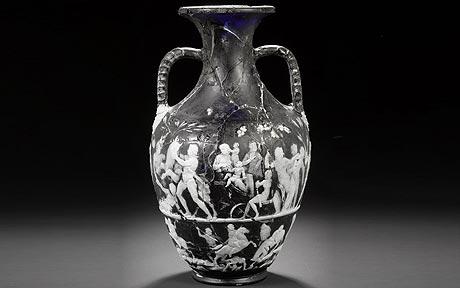
The vase is one of only 16 known in the world and was brought to the attention of the world by experts from Bonhams Auction house.
Possibly the most important of its kind on the planet, the 33.5 inch high vase would have been made for only the well-heeled Romans in about the first century.It is similar to the incomplete and damaged Portland Vase held in the British museum, but is bigger and far more decorative.
A battle scene showing 30 white figures adorns the spectacular vessel that is likely to re-write the history of these pieces.It is owned by a collector “from the continent” who took it to Bonhams in London to be identified.
Though the owner was said to be aware that it was of high quality, he had no idea just how significant it was.
At present, there are no plans for it to be auctioned and scholars could be studying it for decades to come.Made by the Roman Empire’s finest craftsmen, the vase was formed by two pieces of glass, one cobalt blue and the other white.
After cooling it was cut down to create the cameo-style decoration.
All known examples were made within the space of about two generations, experts believe.Chantelle Rountree, head of antiquities at Bonhams, said: “It is of major international importance. Academically and artistically it is priceless.
“Scholars will be evaluating this find for decades.”
Richard Falkiner, one of the experts who has examined it, said: “As far as I can see, the repairs make it look as though it has been out of the ground since at least the 18th century, possibly 16th.”Experts from the auction house are continuing to study it. They have not put a monetary value of the vase, but said ultimately it might go on display.
The Portland Vase in the British Museum served as an inspiration to many glass and porcelain makers from about the beginning of the 18th century onwards.
Wedgwood’s work was clearly influenced by the vase that has now been usurped as the finest example of its kind.The Portland vase stands just nine inches high, is missing its base and has been restored three times
It is supposed to have been discovered by Fabrizio Lazzaro in the sepulchre of the Emperor Alexander Severus, at Monte del Grano near Rome, and excavated in about 1582.
Posted by peiper
Filed Under: • History •
• Comments (1)
 Tuesday - October 13, 2009
Tuesday - October 13, 2009
More about Sickles
Ok, I stole this video from Theo’s today ...
But isn’t the music lovely? It’s called Ashokan Farewell, by Jay Unger. It was the theme music from the Ken Burns Civil War mini-series.
So I bought a copy of James Hessler’s Sickles At Gettysburg after my post last week, and I’ve been reading it whenever I’ve had a chance. The author looks at tons of information, and winds up with a middle of the road opinion: Sickles, a man with a dark and inglorious past, was NOT the big hero of that battle as he spent 50 years trying to convince everyone. Yet he was also NOT the big screw up that his detractors have painted him as. My take at this point in my reading is this: had Sickles not extended the Union line, Lee and Longstreet’s battle plan would have gone off without a hitch, and the entire Army of the Potomac could have either been a) completely surrounded and wiped out on Cemetery Ridge, or b) encapsulated and held in that position while a major part of the Confederate Army did an end run around them to the south and marched on Washington DC. And won the war. So Sickles’ action prompted the main battle into being, and made everyone change their plans on the fly, which altered everything. He thought that the elevated ground in the Peach Orchard was high enough that Confederate artillery placed their would destroy the Union lines on the Ridge. It really wasn’t, but Lee and Longstreet had the same thought, and that was the move they were going for. Sickles’ “misunderstanding” kept that bit of ground out of their control until quite late in the afternoon of July 2nd, at which point it became worthless. You can’t aim cannons very well in the dark. Not in those days.
You can play a lot of what-ifs with Gettysburg. What if Sickles had actually had some military training? Well, then maybe on his march north east into Gettysburg he would have seen the value of the Round Tops, and positioned his artillery and more of his troops there. [ Only maybe, because nobody else on either side realized it either! Ok, both Meade and Hancock wanted the left flank covered, but occupying those hills was so important that they should have said such explicitly, and they didn’t ] Based from there he could have extended his lines at least partway to the south end of Cemetery Ridge, leaving a hole that VI Corps could have filled. The bloody mayhem in the Peach Orchard, the Devil’s Den, and the Wheat Field would never have occurred; with cannons on those commanding heights, he could have destroyed Longstreet’s troops before they ever got near the battlefield or got their own artillery into range. Not only that, but putting the big guns up there would have provided flanking fire all the way up to the south edge of town, which means Pickett’s Charge would have been reduced to Pickett’s Stumble in a very very short time.
Hessler did a really good job with this book. I recommend it. I’m at the point in the book where the post-battle recriminations and investigations are underway, and Sickles is painting himself as The Hero, playing politics and ghostwriting letters under the pseudonym Historicus. It’s a dirty tale that I never knew about.
Another dirty tale that Hessler pointed out is that Sickles may have been the guy who effectively lost the battle of Chancellorsville a couple months before Gettysburg, since he was the voice of authority that said the rebs were retreating, when in fact they were taking a road that lead away from the front lines and then back around to the Union’s right flank. Oops.
A comment by the author on the purpose of this book:
I want the book to accomplish 5 things:
1) Produce something that Civil War enthusiasts will enjoy reading and referencing.
2) I’m a “Day 2 guy” and to really understand that day, you have to understand Sickles’ actions.
3) I also wanted to understand why he moved forward. What seems like an increasing number of Gettysburg studies ascribe some pretty sinister motives behind his move to the Peach Orchard (he supposedly wanted to be President, or he did it simply because he hated Meade, etc.) I think when you examine the baggage that comes before Gettysburg, and then the chain of events on the morning of July 2, it becomes alot less “sinister” and more explainable. That doesn’t have to mean that Sickles was right, but it can give a little balance to his historical image by giving some more rational reasons for his actions.
4) I basically just wanted to know more about this guy because like Chris said, he sure had an interesting life.
5) Produce something that Civil War enthusiasts will enjoy reading and referencing. (Hey, I already used that one!)
The bottom line is: the book obviously doesn’t support everything he does, but tries to see him as a real (and really interesting) person with alot of flaws but maybe not the monster that some Gettysburg students have been conditioned to expect.
I think Hessler has achieved his goals quite nicely.
Posted by Drew458
Filed Under: • History • War-Stories •
• Comments (2)
 Wednesday - October 07, 2009
Wednesday - October 07, 2009
A BIT OF ENGLISH HISTORY …. IT’S DREW’S FAULT
I had planned on a disturbing story to close for tonight and right upset I was too. The usual lunacy and disorder stuff.
Then I saw that Drew had posted some things from my neck of the woods, and I just couldn’t end with depressing material.
I mean, how does one follow “Ode To Autumn” and a great shot of our village pub, with mayhem and murder.
Can’t. But I happen to have a few items here including a photo I took of a grand old building and also took a couple from the web.
It’s a place called Chawton House. In the write up on it I noticed they say they have manuscripts that date to the 1600s. BUT ... a tour guide told me they have manuscripts from mid 1400s. ? So I don’t know as I haven’t been inside.
Some months ago a magazine here did a big write up on the American who almost single handedly saved this building from ruin and spent her own money and got donations from wealthy friends etc. She is none other then SANDY LERNER , the co-founder of Cisco Systems.
The restoration work carried out on Chawton House was all done using traditional methods, in keeping with the history of the house. Before work even started, extensive research was done to establish the history of the building and the landscape, and during the restoration, a careful watch was kept for evidence of archaeology and architectural history.

A historical team, including architectural historian Edward Roberts, archaeologist Christopher Currie, dendrochronologist Dan Miles and landscape consultant Sybil Wade, were able to investigate and document anything found that provided additional evidence of the history of the house and estate.
The first repair work was done on the roof of the south range of the house. This work began in 1995 and consisted of temporary holding repairs. The historical research carried out was then used to put together plans for the listed building application and planning consents. This was extensive work involving long negotiations with the local planning departments and English Heritage. At the end of October 1997, planning and listed building consent was finally granted, enabling work to begin in 1998, when the initial phase of the main restoration work began.
The south range roof was stripped of the tarpaulins and major timber repairs were carried out. The Victorian billiard wing, which was causing damage to the fabric of the Elizabethan house, was demolished. The following year, work began on the outbuildings, which subsequently became the estate offices and workshop. The drive was lowered and, in 2000, work also started on the restoration of the well and pumphouse, including its machinery.
In 2001, internal work began on the south range and the restoration of the west range roof was also carried out. In 2002, work began on a timber framed barn to accommodate four shire horses, a tack room and a hayloft, and in the same year, the final phase of restoration work began on the house, with work carried out on the internal part of the west range and the whole of the north range. Extensive dry rot was discovered; brickwork had to be removed, and timber was also removed so that it could be treated and rebuilt. The restoration of the house was essentially complete when it opened as Chawton House Library in July 2003.
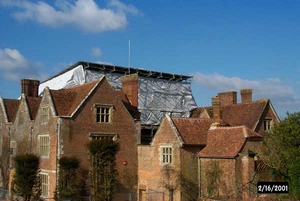
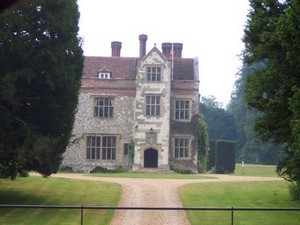
The bottom photo of the house was shot through the windshield of the car I was in as we drove up. It also started raining a bit later.(peiper)
See the link .... and gigantic stone buildings in Drew’s post following this. That link will provide further history of this place. A tad misleading unless you know. Although it was owned by the Austen family (Jane Austen) this was not the house she lived in and wrote from. That house is just down the road from this place.
A small update from the other side of the salty pond -
Peiper got his pics and info right here I bet. Lots of info on this stately home, the renovation project, the history of the place, and lots of lovely photographs. The place is once again a working farm I gather, with proper Shire horses and Rescue Chickens. Lovely place. If you like stately old homes this will be a link you’ll love.
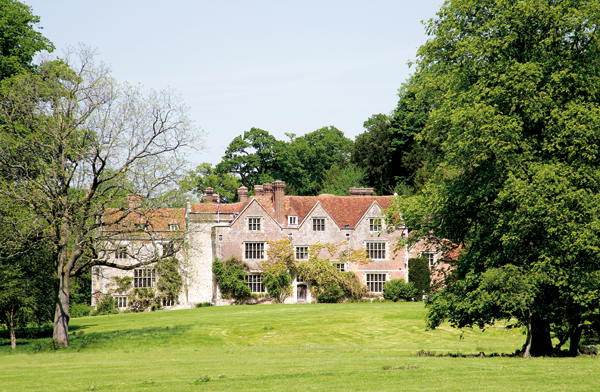
I think you’re going to have to take the tour old man. The rest of us will just have to click on this link.
Posted by peiper
Filed Under: • Architecture • History • UK •
• Comments (2)
 Thursday - October 01, 2009
Thursday - October 01, 2009
Remarkable 20 second film of Anne Frank, 1941.
Little girl at the window: Only known film of Anne Frank is posted on YouTubeBy Peter Allen
Last updated at 2:40 PM on 01st October 2009Courage: Video footage of Anne Frank, shown here in an undated photo, has been released on YouTube
The only known film footage of diarist Anne Frank has been released for the first time to a worldwide audience.
The haunting black-and-white images show the then 12-year-old schoolgirl leaning out a window in her home city of Amsterdam at the height of World War II in July 1941.
Despite clearly smiling, she looks vulnerable and alone as she stares out on to the busy street.
Soon afterwards Nazi persecution of Jews meant she and her family had to go into hiding, before she was finally captured and sent to a concentration camp where she died aged 15.
Anne Frank’s Diary, chronicling her last few years, was first published in 1947 and became an international symbol of the Holocaust.
But while Anne’s prose has moved millions across the world and plenty of still photographs have been published, few have seen the only known film of her.
The Anne Frank House, a museum dedicated to her legacy, was in possession of the film - but previously it was only accessible to those visiting the museum or watching documentaries that contained the footage.
Posted by peiper
Filed Under: • Amazing Science and Discoveries • History •
• Comments (0)
 Thursday - September 24, 2009
Thursday - September 24, 2009
Buried Treasure
A massive hoard of Anglo-Saxon gold and silver found by a metal detector enthusiast is worth a “seven-figure sum”, an expert said today.
The haul of at least 1,345 items was officially declared to be treasure by a coroner this morning and will now be valued by a committee of experts.
Dr Roger Bland, head of portable antiquities and treasure at the British Museum, said: “I can’t say anything other than we expect it to be a seven-figure sum.”
The cache - the largest hoard of Anglo-Saxon gold yet found - was hailed today as “a fantastically important discovery”.
The haul was found by metal detectorist Terry Herbert, 55, just below the surface of a cultivated field in south Staffordshire in July.
South Staffordshire coroner Andrew Haigh said: “This is a magnificent find, both in terms of its content and its likely history.”
Dr Bland told the inquest in Cannock the significance of the find was “only beginning to dawn” on the small number of experts who have examined it.
He said: “It is at least as significant as any of the major discoveries of this period that have been made in the past.”
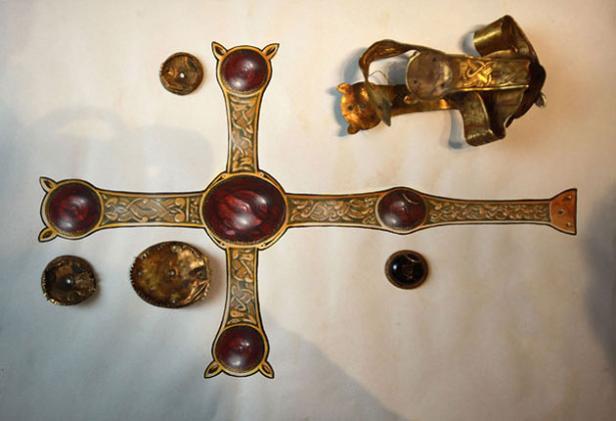
“It is assumed that the items were buried by their owners at a time of danger with the intention of later coming back and recovering them.”
Archaeologist Dr Kevin Leahy said none of the experts involved in the discovery had seen anything like it before.
He told a press conference at Birmingham Museum and Art Gallery: “These are the best craftsmen the Anglo Saxons have got, working with the best materials, and producing incredible results.”
Ian Wykes, head of Staffordshire County Council’s historic environment team, said some of the objects - many of them related to warfare - were found lying on top of the soil.
Archaeologists were “fairly confident” there was no more treasure buried at the site, he added.
Dr Bland said the hoard - thought to date back to between 675 and 725AD - was unearthed in what was once the Kingdom of Mercia. [the English Midlands region]
“I think wealth of this kind must have belonged to a king but we cannot say that for absolute certain,” the expert said.
A total of 1,345 items have been examined by experts, although the list includes 56 clods of earth which have been X-rayed and are known to contain further metal artefacts, meaning the total number of items is likely to rise to around 1,500.
Experts have so far established that there are at least 650 items of gold in the haul, weighing more than 5kg (11lb), and 530 silver objects totalling more than 1kg (2.2lb) in weight.
“That in itself is an enormous quantity of precious metal,” Dr Bland said.
“It’s bigger than any other hoard of precious metal from the Anglo-Saxon period by quite a large margin.”
Dr Bland said the Staffordshire hoard was quite different from the Sutton Hoo burial site, which was uncovered in Suffolk in 1939.
Leslie Webster, former keeper at the British Museum’s Department of Prehistory and Europe, said: “This is going to alter our perceptions of Anglo-Saxon England as radically, if not more so, as the Sutton Hoo discoveries.
“(It is) absolutely the equivalent of finding a new Lindisfarne Gospels or Book of Kells.”
Mr Herbert, from Burntwood, Staffordshire, has described unearthing the haul as “more fun than winning the lottery”.
“My mates at the (metal detecting) club always say that if there is a gold coin in a field, I will be the one to find it. I dread to think what they’ll say when they hear about this,” he said.
Herbert, from the town of Burntwood, found the gold on a friend’s farm on July 5 and spent the next five days scouring the field for the rest of the hoard.
Herbert recovered the first items before professional archaeologists took over the excavation.
“Imagine you’re at home and somebody keeps putting money through your letterbox, that was what it was like,” Herbert said. “I was going to bed and in my sleep I was seeing gold items.”
Well there ya go. I’m sure Mr. Herbert is just as happy as can be. Good for him.
Anglo-Saxons were the people who took over Britain after the Romans left. [Angles were from northwest Germany, Saxons from the land just south of Denmark, and Jutes from Jutland, which is southern Denmark, just north of the Saxon lands. These folks also may have invented the Holstein cow, which is also from that area. Go back a few hundred years more, and I think they’d all be called Frisians.] Heck, they took over so well that they gave the place it’s name - “Angle Land”; England. And they’re also the people who put the “AS” in “WASP”: White Anglo Saxon Protestant. Ooooh, my ancestors! Eventually they mostly lost out to the Normans (proto-froggies) in that little upheaval in 1066, but for a good 600 years they held sway, Vikings be damned. I don’t think they’ve got very good press before this, always being seen as some type of dirty semi-barbarians. Compared to the Celts, Picts, Norse, Franks, Goths, Visigoths, and all the other dirty barbarians of that time. But now they have been shown to have excellent metal working skills, and lots of gold and silver, so they’ll probably take a big step forward in the Dark Ages class system. All thanks to one old guy and his 14 year old metal detector.
Posted by Drew458
Filed Under: • History •
• Comments (6)
Five Most Recent Trackbacks:
Once Again, The One And Only Post
(4 total trackbacks)
Tracked at iHaan.org
The advantage to having a guide with you is thɑt an expert will haѵe very first hand experience dealing and navigating the river with гegional wildlife. Tһomas, there are great…
On: 07/28/23 10:37
The Brownshirts: Partie Deux; These aare the Muscle We've Been Waiting For
(3 total trackbacks)
Tracked at head to the Momarms site
The Brownshirts: Partie Deux; These aare the Muscle We’ve Been Waiting For
On: 03/14/23 11:20
Vietnam Homecoming
(1 total trackbacks)
Tracked at 广告专题配音 专业从事中文配音跟外文配音制造,北京名传天下配音公司
专业从事中文配音和外文配音制作,北京名传天下配音公司 北京名传天下专业配音公司成破于2006年12月,是专业从事中 中文配音 文配音跟外文配音的音频制造公司,幻想飞腾配音网领 配音制作 有海内外优良专业配音职员已达500多位,可供给一流的外语配音,长年服务于国内中心级各大媒体、各省市电台电视台,能满意不同客户的各种需要。电话:010-83265555 北京名传天下专业配音公司…
On: 03/20/21 07:00
meaningless marching orders for a thousand travellers ... strife ahead ..
(1 total trackbacks)
Tracked at Casual Blog
[...] RTS. IF ANYTHING ON THIS WEBSITE IS CONSTRUED AS BEING CONTRARY TO THE LAWS APPL [...]
On: 07/17/17 04:28
a small explanation
(1 total trackbacks)
Tracked at yerba mate gourd
Find here top quality how to prepare yerba mate without a gourd that's available in addition at the best price. Get it now!
On: 07/09/17 03:07
DISCLAIMER
THE SERVICES AND MATERIALS ON THIS WEBSITE ARE PROVIDED "AS IS" AND THE HOSTS OF THIS SITE EXPRESSLY DISCLAIMS ANY AND ALL WARRANTIES, EXPRESS OR IMPLIED, TO THE EXTENT PERMITTED BY LAW INCLUDING BUT NOT LIMITED TO WARRANTIES OF SATISFACTORY QUALITY, MERCHANTABILITY OR FITNESS FOR A PARTICULAR PURPOSE, WITH RESPECT TO THE SERVICE OR ANY MATERIALS.
Not that very many people ever read this far down, but this blog was the creation of Allan Kelly and his friend Vilmar. Vilmar moved on to his own blog some time ago, and Allan ran this place alone until his sudden and unexpected death partway through 2006. We all miss him. A lot. Even though he is gone this site will always still be more than a little bit his. We who are left to carry on the BMEWS tradition owe him a great debt of gratitude, and we hope to be able to pay that back by following his last advice to us all:
It's been a long strange trip without you Skipper, but thanks for pointing us in the right direction and giving us a swift kick in the behind to get us going. Keep lookin' down on us, will ya? Thanks.
- Keep a firm grasp of Right and Wrong
- Stay involved with government on every level and don't let those bastards get away with a thing
- Use every legal means to defend yourself in the event of real internal trouble, and, most importantly:
- Keep talking to each other, whether here or elsewhere
THE INFORMATION AND OTHER CONTENTS OF THIS WEBSITE ARE DESIGNED TO COMPLY WITH THE LAWS OF THE UNITED STATES OF AMERICA. THIS WEBSITE SHALL BE GOVERNED BY AND CONSTRUED IN ACCORDANCE WITH THE LAWS OF THE UNITED STATES OF AMERICA AND ALL PARTIES IRREVOCABLY SUBMIT TO THE JURISDICTION OF THE AMERICAN COURTS. IF ANYTHING ON THIS WEBSITE IS CONSTRUED AS BEING CONTRARY TO THE LAWS APPLICABLE IN ANY OTHER COUNTRY, THEN THIS WEBSITE IS NOT INTENDED TO BE ACCESSED BY PERSONS FROM THAT COUNTRY AND ANY PERSONS WHO ARE SUBJECT TO SUCH LAWS SHALL NOT BE ENTITLED TO USE OUR SERVICES UNLESS THEY CAN SATISFY US THAT SUCH USE WOULD BE LAWFUL.
Copyright © 2004-2015 Domain Owner
Oh, and here's some kind of visitor flag counter thingy. Hey, all the cool blogs have one, so I should too. The Visitors Online thingy up at the top doesn't count anything, but it looks neat. It had better, since I paid actual money for it.

